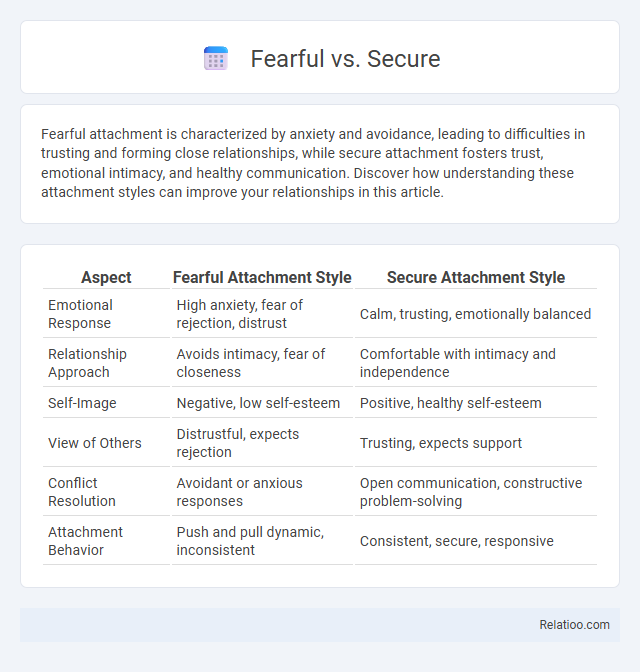Fearful attachment is characterized by anxiety and avoidance, leading to difficulties in trusting and forming close relationships, while secure attachment fosters trust, emotional intimacy, and healthy communication. Discover how understanding these attachment styles can improve your relationships in this article.
Table of Comparison
| Aspect | Fearful Attachment Style | Secure Attachment Style |
|---|---|---|
| Emotional Response | High anxiety, fear of rejection, distrust | Calm, trusting, emotionally balanced |
| Relationship Approach | Avoids intimacy, fear of closeness | Comfortable with intimacy and independence |
| Self-Image | Negative, low self-esteem | Positive, healthy self-esteem |
| View of Others | Distrustful, expects rejection | Trusting, expects support |
| Conflict Resolution | Avoidant or anxious responses | Open communication, constructive problem-solving |
| Attachment Behavior | Push and pull dynamic, inconsistent | Consistent, secure, responsive |
Understanding Fearful vs Secure Attachment Styles
Fearful attachment is characterized by a deep fear of rejection combined with a desire for closeness, often leading to avoidance of intimacy due to trust issues. Secure attachment involves comfort with intimacy and autonomy, resulting in healthy, trusting relationships and effective emotional regulation. Understanding the differences between fearful and secure attachment styles is crucial for recognizing relationship patterns and promoting emotional healing and growth.
Defining Characteristics of Fearful Attachment
Fearful attachment is characterized by a deep desire for closeness combined with intense fear of rejection or abandonment, leading to ambivalent behavior in relationships. Individuals with this attachment style often struggle with low self-esteem and difficulty trusting others, resulting in a push-pull dynamic. Your awareness of these defining traits can help in recognizing and addressing insecure patterns to cultivate healthier, secure connections.
Key Traits of Secure Attachment
Secure attachment is characterized by trust, emotional availability, and effective communication in relationships. Individuals with secure attachment display confidence in intimacy, resilience to stress, and the ability to seek support when needed. Key traits include balanced dependency, healthy boundaries, and consistent emotional regulation, promoting stable and fulfilling interpersonal connections.
How Fearful Attachment Develops
Fearful attachment develops primarily through early experiences of inconsistent caregiving, where Your needs for safety and trust were met unpredictably, leading to confusion and anxiety. This attachment style combines a deep desire for closeness with intense fear of rejection or abandonment, resulting in conflicted emotions and avoidance behaviors. Understanding the origins of fearful attachment is crucial for addressing emotional challenges and fostering healthier relationships.
Origins of Secure Attachment
Origins of secure attachment stem from consistent and responsive caregiving in early childhood, where caregivers meet a child's emotional and physical needs reliably. Your ability to develop secure attachments is influenced by these formative experiences, fostering trust and emotional regulation. In contrast, fearful attachment often arises from inconsistent or neglectful care, leading to anxiety and difficulty in relationships.
Emotional Impact: Fearful vs Secure Responses
Fearful attachment triggers heightened anxiety and insecurity, leading to emotional volatility and difficulty in trusting others, whereas secure attachment fosters stable self-esteem and consistent emotional regulation. Fearful individuals often experience intense fear of rejection and abandonment, resulting in withdrawal or clinginess, while securely attached people maintain healthy boundaries and effective communication. The emotional impact of fearful versus secure responses significantly shapes relationship dynamics, influencing conflict resolution and intimacy levels.
Relationship Dynamics and Communication Patterns
Fearful attachment in relationships often results in inconsistent communication patterns marked by anxiety and withdrawal, creating challenges in trust and emotional intimacy. Secure attachment fosters open, honest communication and balanced emotional expression, promoting healthy relationship dynamics grounded in mutual support and understanding. Your ability to recognize these attachment styles can improve relationship satisfaction by encouraging more effective interactions and emotional regulation.
Navigating Conflict: Fearful vs Secure Behaviors
Fearful attachment behaviors often include avoidance of conflict and heightened anxiety around potential rejection, whereas secure individuals approach disagreements with open communication and emotional regulation. You can navigate conflict effectively by recognizing fearful tendencies such as withdrawal or excessive worry, then fostering secure behaviors like active listening and expressing feelings calmly. Developing secure conflict responses leads to healthier relationships and reduced stress during challenging interactions.
Pathways from Fearful to Secure Attachment
Fearful attachment often stems from inconsistent caregiving, leading to a combination of anxiety and avoidance in relationships, whereas secure attachment is characterized by trust and emotional stability. Your pathway from fearful to secure attachment involves developing self-awareness, fostering emotional regulation, and building consistent, supportive relationships that reinforce safety and trust. Therapeutic techniques like cognitive-behavioral therapy and mindfulness can effectively help rewire negative core beliefs, promoting healthier relational patterns and emotional resilience.
Building Healthier Relationships: Practical Strategies
Fearful, secure, and fearful attachment styles profoundly impact how you build and maintain relationships, affecting communication, trust, and emotional intimacy. To foster healthier connections, individuals with fearful attachment should prioritize self-awareness and therapy to overcome trust issues, while those with secure attachment naturally benefit from open communication and empathy. Implementing mindfulness practices and setting clear boundaries can help manage anxiety and promote emotional safety in all relationship dynamics.

Infographic: Fearful vs Secure
 relatioo.com
relatioo.com